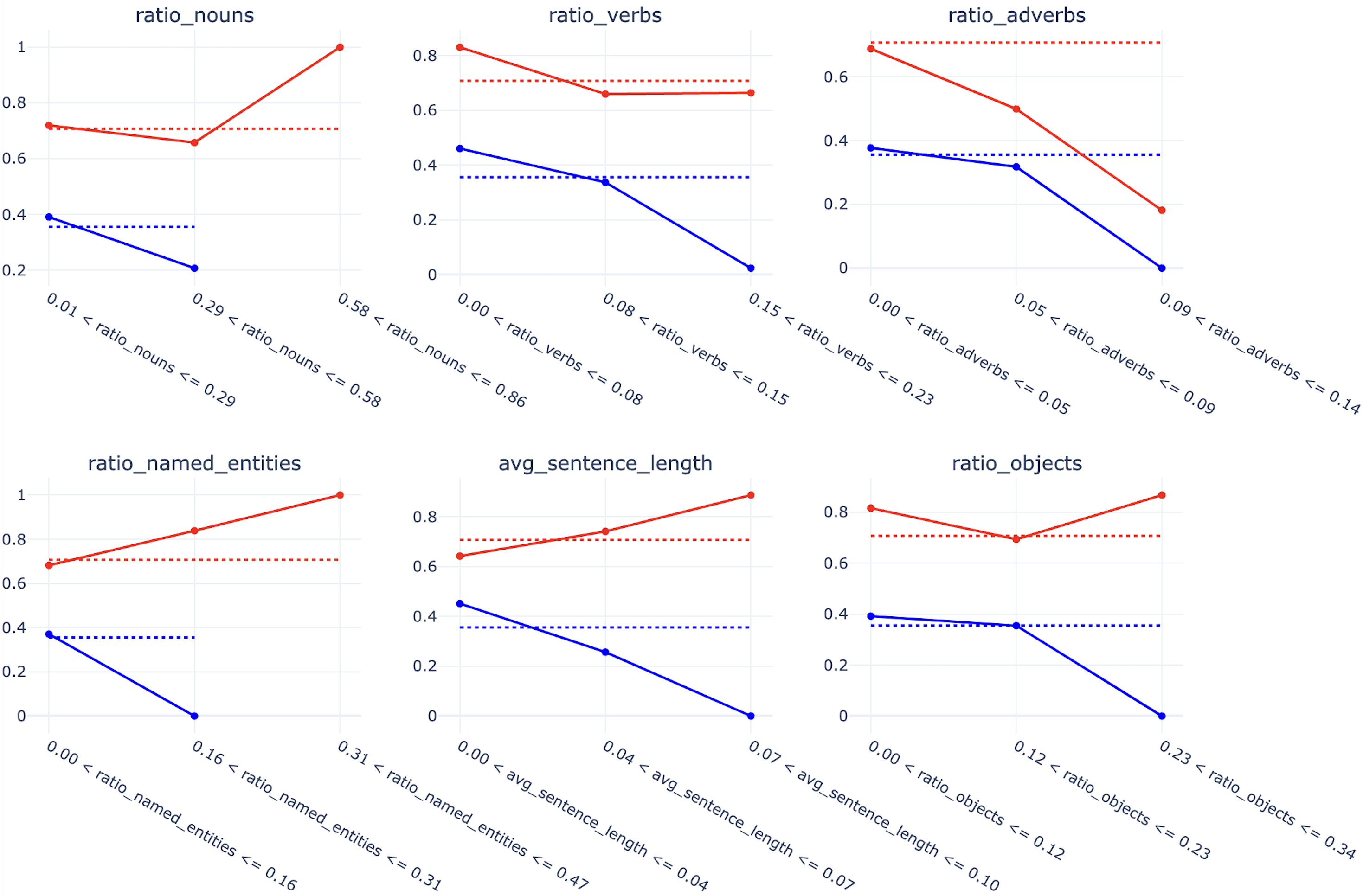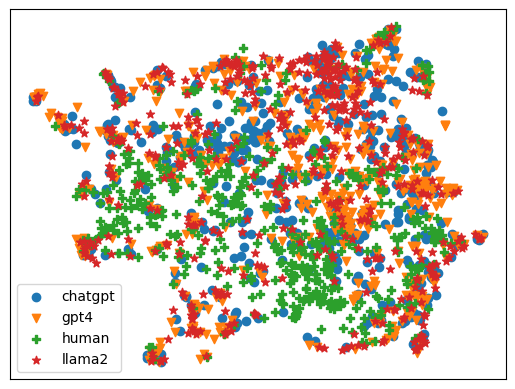Exploring the Limitations of Detecting Machine-Generated Text
2406.11073

0
0

Abstract
Recent improvements in the quality of the generations by large language models have spurred research into identifying machine-generated text. Systems proposed for the task often achieve high performance. However, humans and machines can produce text in different styles and in different domains, and it remains unclear whether machine generated-text detection models favour particular styles or domains. In this paper, we critically examine the classification performance for detecting machine-generated text by evaluating on texts with varying writing styles. We find that classifiers are highly sensitive to stylistic changes and differences in text complexity, and in some cases degrade entirely to random classifiers. We further find that detection systems are particularly susceptible to misclassify easy-to-read texts while they have high performance for complex texts.
Create account to get full access
Overview
- This paper explores the limitations of current approaches to detecting machine-generated text.
- It examines the performance of various state-of-the-art text detection models and identifies key challenges in accurately distinguishing human-written and AI-generated content.
- The research aims to shed light on the evolving landscape of text authenticity and the need for more robust detection techniques.
Plain English Explanation
As artificial intelligence (AI) models become more advanced at generating human-like text, it is becoming increasingly difficult to reliably detect when text is machine-generated. This paper investigates the limitations of existing techniques for identifying AI-generated content. Beyond Turing: A Comparative Analysis of Approaches to Detecting Machine-Generated Text, Few-Shot Detection of Machine-Generated Text Using Transformer-Based Language Models, and other related studies have explored this challenge, but more research is needed to stay ahead of the rapidly evolving technology.
The researchers tested the performance of several state-of-the-art text detection models, evaluating their ability to accurately distinguish between human-written and AI-generated content. They identified key difficulties, such as the models' sensitivity to context, their limitations in detecting more advanced AI-generated text, and the need for more robust and generalizable detection approaches. Deciphering Textual Authenticity: A Generalized Strategy Through the Lens of MAGE and MAGE: Machine-Generated Text Detection in the Wild provide relevant insights into these challenges.
Understanding the limitations of current text detection methods is crucial as AI language models become increasingly sophisticated and accessible. This research highlights the need for more advanced and adaptable techniques to ensure the integrity of written communication, MUGC: Machine-Generated versus User-Generated Content and maintain trust in the digital landscape.
Technical Explanation
The paper presents a comprehensive analysis of the performance of various state-of-the-art text detection models in distinguishing between human-written and AI-generated content. The researchers evaluated the models' accuracy, sensitivity to context, and ability to generalize to different types of AI-generated text.
The experiment design involved feeding the models a diverse dataset of human-written and machine-generated text, including samples from different AI language models and various writing styles. The models' outputs were then analyzed to identify their strengths, weaknesses, and potential biases.
The key insights from the study include the models' sensitivity to contextual factors, such as the source of the text or the specific AI model used to generate it. The researchers also found that the models struggled to detect more advanced AI-generated text, which exhibited increasingly human-like characteristics. This highlights the need for more robust and generalizable detection approaches that can adapt to the evolving landscape of text generation.
The findings of this research contribute to the ongoing efforts to develop more effective techniques for ensuring the authenticity of written communication in the face of rapidly advancing AI language models.
Critical Analysis
The paper provides a valuable contribution to the field by systematically exploring the limitations of current text detection models. However, it is important to note that the research is limited to a specific set of models and datasets, and the findings may not necessarily generalize to all text detection approaches or real-world scenarios.
One potential concern is the paper's focus on a relatively narrow set of AI language models, which may not represent the full range of text generation capabilities currently available or in development. As the field of AI continues to progress, it is crucial to consider the potential emergence of even more advanced text generation techniques that could further challenge the existing detection methods.
Additionally, the paper does not delve deeply into the potential societal implications of the limitations in text detection. As AI-generated content becomes more prevalent, the ability to reliably distinguish it from human-written text has far-reaching consequences, from issues of misinformation and manipulation to the impact on various industries and professions.
Further research is needed to address these broader implications and to develop more comprehensive and adaptive detection strategies that can keep pace with the rapid advancements in text generation technology. Deciphering Textual Authenticity: A Generalized Strategy Through the Lens of MAGE and MUGC: Machine-Generated versus User-Generated Content provide additional perspectives on these challenges.
Conclusion
This paper offers a critical examination of the limitations of current approaches to detecting machine-generated text. As AI language models become increasingly sophisticated, the ability to reliably distinguish between human-written and AI-generated content is becoming increasingly challenging.
The research highlights the need for more robust and adaptable detection techniques that can keep pace with the rapidly evolving landscape of text generation. The findings contribute to a broader understanding of the challenges in ensuring the authenticity of written communication and the potential societal implications of this issue.
Continued research and collaboration across various disciplines will be crucial in developing effective solutions to address the limitations identified in this paper and maintain trust in the digital age.
This summary was produced with help from an AI and may contain inaccuracies - check out the links to read the original source documents!
Related Papers
📶
Beyond Turing: A Comparative Analysis of Approaches for Detecting Machine-Generated Text
Muhammad Farid Adilazuarda

0
0
Significant progress has been made on text generation by pre-trained language models (PLMs), yet distinguishing between human and machine-generated text poses an escalating challenge. This paper offers an in-depth evaluation of three distinct methods used to address this task: traditional shallow learning, Language Model (LM) fine-tuning, and Multilingual Model fine-tuning. These approaches are rigorously tested on a wide range of machine-generated texts, providing a benchmark of their competence in distinguishing between human-authored and machine-authored linguistic constructs. The results reveal considerable differences in performance across methods, thus emphasizing the continued need for advancement in this crucial area of NLP. This study offers valuable insights and paves the way for future research aimed at creating robust and highly discriminative models.
5/16/2024

Few-Shot Detection of Machine-Generated Text using Style Representations
Rafael Rivera Soto, Kailin Koch, Aleem Khan, Barry Chen, Marcus Bishop, Nicholas Andrews

0
0
The advent of instruction-tuned language models that convincingly mimic human writing poses a significant risk of abuse. However, such abuse may be counteracted with the ability to detect whether a piece of text was composed by a language model rather than a human author. Some previous approaches to this problem have relied on supervised methods by training on corpora of confirmed human- and machine- written documents. Unfortunately, model under-specification poses an unavoidable challenge for neural network-based detectors, making them brittle in the face of data shifts, such as the release of newer language models producing still more fluent text than the models used to train the detectors. Other approaches require access to the models that may have generated a document in question, which is often impractical. In light of these challenges, we pursue a fundamentally different approach not relying on samples from language models of concern at training time. Instead, we propose to leverage representations of writing style estimated from human-authored text. Indeed, we find that features effective at distinguishing among human authors are also effective at distinguishing human from machine authors, including state-of-the-art large language models like Llama-2, ChatGPT, and GPT-4. Furthermore, given a handful of examples composed by each of several specific language models of interest, our approach affords the ability to predict which model generated a given document. The code and data to reproduce our experiments are available at https://github.com/LLNL/LUAR/tree/main/fewshot_iclr2024.
5/9/2024

Deciphering Textual Authenticity: A Generalized Strategy through the Lens of Large Language Semantics for Detecting Human vs. Machine-Generated Text
Mazal Bethany, Brandon Wherry, Emet Bethany, Nishant Vishwamitra, Anthony Rios, Peyman Najafirad

0
0
With the recent proliferation of Large Language Models (LLMs), there has been an increasing demand for tools to detect machine-generated text. The effective detection of machine-generated text face two pertinent problems: First, they are severely limited in generalizing against real-world scenarios, where machine-generated text is produced by a variety of generators, including but not limited to GPT-4 and Dolly, and spans diverse domains, ranging from academic manuscripts to social media posts. Second, existing detection methodologies treat texts produced by LLMs through a restrictive binary classification lens, neglecting the nuanced diversity of artifacts generated by different LLMs. In this work, we undertake a systematic study on the detection of machine-generated text in real-world scenarios. We first study the effectiveness of state-of-the-art approaches and find that they are severely limited against text produced by diverse generators and domains in the real world. Furthermore, t-SNE visualizations of the embeddings from a pretrained LLM's encoder show that they cannot reliably distinguish between human and machine-generated text. Based on our findings, we introduce a novel system, T5LLMCipher, for detecting machine-generated text using a pretrained T5 encoder combined with LLM embedding sub-clustering to address the text produced by diverse generators and domains in the real world. We evaluate our approach across 9 machine-generated text systems and 9 domains and find that our approach provides state-of-the-art generalization ability, with an average increase in F1 score on machine-generated text of 19.6% on unseen generators and domains compared to the top performing existing approaches and correctly attributes the generator of text with an accuracy of 93.6%.
4/4/2024
🔎
Deepfake Text Detection in the Wild
Yafu Li, Qintong Li, Leyang Cui, Wei Bi, Zhilin Wang, Longyue Wang, Linyi Yang, Shuming Shi, Yue Zhang

0
0
Large language models (LLMs) have achieved human-level text generation, emphasizing the need for effective AI-generated text detection to mitigate risks like the spread of fake news and plagiarism. Existing research has been constrained by evaluating detection methods on specific domains or particular language models. In practical scenarios, however, the detector faces texts from various domains or LLMs without knowing their sources. To this end, we build a comprehensive testbed by gathering texts from diverse human writings and texts generated by different LLMs. Empirical results show challenges in distinguishing machine-generated texts from human-authored ones across various scenarios, especially out-of-distribution. These challenges are due to the decreasing linguistic distinctions between the two sources. Despite challenges, the top-performing detector can identify 86.54% out-of-domain texts generated by a new LLM, indicating the feasibility for application scenarios. We release our resources at https://github.com/yafuly/MAGE.
5/22/2024